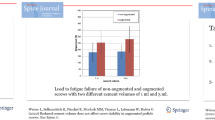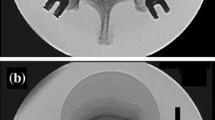Abstract
Study Design
Biomechanical study using a finite element model of a normal and osteoporotic lumbar vertebrae comparing resistance with axial pullout and bending forces on polymethylmethacrylate-augmented and non-augmented pedicle screws.
Objective
To compare the effect of cement augmentation of pedicle screw fixation in normal and osteoporotic bone with 2 different techniques of cement delivery.
Summary of Background Data
Various clinical and biomechanical studies have addressed the benefits of cement augmentation of pedicle screws, but none have evaluated whether this effect is similar, magnified, or attenuated in osteoporotic bone compared with normal bone. In addition, no study has compared the biomechanical strength of augmented pedicle screws using cement delivery through the pedicle screw with delivery through a pilot hole.
Methods
This study was funded by a grant from DePuy Synthes Spine. Normal and osteoporotic lumbar vertebrae with pedicle screws were simulated. The models were tested for screw pullout strength with and without cement augmentation. Two methods of cement delivery were also tested. Both methods were tested using 1 and 2.5 cm3 volume of cement infiltrated in normal and oste- oporotic bone.
Results
The increase in screw pullout force was proportionally greater in osteoporotic bone with equivalent volumes of cement delivered. The researchers found that 1 and 2.5 cm3 of cement infiltrated bone volume resulted in an increase in pullout force by about 50% and 120% in normal bone, and by about 64% and 156% in osteoporotic bone, respectively. The delivery method had only a minimal effect on pullout force when 2.5 cm3 of cement was injected (<4% difference).
Conclusions
Cement augmentation increases the fixation strength of pedicle screws, and this effect is proportionately greater in osteo- porotic bone. Cement delivery through fenestrated screws and delivery through a pilot hole result in comparable pullout strength at higher cement volumes.
Similar content being viewed by others
References
Frankel BM, Jones T, Wang C. Segmental polymethylmethacrylateaugmented pedicle screw fixation in patients with bone softening caused by osteoporosis and metastatic tumor involvement: a clinical evaluation. Neurosurgery 2007;61:531–7.
Flahiff CM, Gober GA, Nicholas RW. Pullout strength of fixation screws from polymethylmethacrylate bone cement. Biomaterials 1995;16:533–6.
Cameron HU, Jacob R, Macnab I, et al. Use of polymethylmethacrylate to enhance screw fixation in bone. J Bone Joint Surg Am 1975;57:655–6.
Zindrick MR, Wiltse LL, Widell EH, et al. A biomechanical study of intrapeduncular screw fixation in the lumbosacral spine. Clin Orthop Relat Res 1986;203:99–112.
Sarzier JS, Evans AJ, Cahill DW. Increased pedicle screw pullout strength with vertebroplasty augmentation in osteoporotic spines. J Neurosurg 2002;96:309–12.
Soshi S, Shiba R, Kondo H, et al. An experimental study on transpedicular screw fixation in relation to osteoporosis of the lumbar spine. Spine (Phila Pa 1976) 1991;16:1335–41.
Blattert TR, Glasmacher S, Riesner HJ, et al. Revision characteristics of cement-augmented, cannulated-fenestrated pedicle screws in the osteoporotic vertebral body: a biomechanical in vitro investigation. Technical note. J Neurosurg Spine 2009;11:23–7.
Wittenberg RH, Lee KS, Shea M, et al. Effect of screw diameter, insertion technique, and bone cement augmentation of pedicular screw fixation strength. Clin Orthop Relat Res 1993;296:278–87.
Cook SD, Salkeld SL, Stanley T, et al. Biomechanical study of pedicle screw fixation in severely osteoporotic bone. Spine J 2004;4:402–8.
Gaines Jr RW. The use of pedicle-screw internal fixation for the operative treatment of spinal disorders. J Bone Joint Surg Am 2000;82: 1458–76.
Vant C, Staat M, Baroud G. Percutaneous vertebroplasty: a review of two intraoperative complications. In: Artmann GM, editor. Bioengineering in cell and tissue research. Berlin: Springer; 2008.
Smit TH, Odgaard A, Schneider E. Structure and function of vertebral trabecular bone. Spine (Phila Pa 1976) 1997;22:2823–33.
Panjabi MM, Goel V, Oxland T, et al. Human lumbar vertebrae: quantitative three-dimensional anatomy. Spine (Phila Pa 1976) 1992;17: 299–306.
Ritzel H, Amling M, Posl M, et al. The thickness of human vertebral cortical bone and its changes in aging and osteoporosis: a histomor-phometric analysis of the complete spinal column from thirty-seven autopsy specimens. J Bone Miner Res 1997;12:89–95.
Yazu N, Kin A, Kosaka R, et al. Efficacy of novel-concept pedicle screw fixation augmented with calcium phosphate cement in the osteoporotic spine. J Orthop Sci 2005;10:56–61.
Baroud G, Crookshank M, Bohner M. High-viscosity cement significantly enhances uniformity of cement filling in vertebroplasty: an experimental model and study on cement leakage. Spine (Phila Pa 1976) 2006;31:2562–8.
Chizari M, Wang B, Snow M, editors. Experimental and numerical analysis of screw fixation in anterior cruciate ligament reconstruction. Paper presented at: World Congress of Engineering; July 2–4, 2007; London, UK.
Perez MA, Nuno N, Madrala A, et al. Computational modelling of bone cement polymerization: temperature and residual stresses. Comput Biol Med 2009;39:751–9.
Mann KA, Bartel DL, Wright TM, et al. Mechanical characteristics of the stem-cement interface. J Orthop Res 1991;9:798–808.
Mann KA, Bartel DL, Wright TM, et al. Coulomb frictional interfaces in modeling cemented total hip replacements: a more realistic model. J Biomech 1995;28:1067–78.
Shirazi-Adl A, Dammak M, Paiement G. Experimental determination of friction characteristics at the trabecular bone/porous-coated metal interface in cementless implants. J Biomed Mater Res 1993;27:167–75.
Chevalier Y, Pahr D, Zysset PK. The role of cortical shell and trabecular fabric in finite element analysis of the human vertebral body. J Biomech Eng 2009;131:111003.
Polikeit A, Nolte LP, Ferguson SJ. Simulated influence of osteoporosis and disc degeneration on the load transfer in a lumbar functional spinal unit. J Biomech 2004;37:1061–9.
Augat P, Link T, Lang TF, et al. Anisotropy of the elastic modulus of trabecular bone specimens from different anatomical locations. Med Eng Phys 1998;20:124–31.
Keaveny TM, Buckley JM. Biomechanics of vertebral bone. In: Kurtz SM, Edidin AA, editors. The spine technology handbook. Burlington, MA: Elsevier Academic Press; 2006. p. 63–98.
Polikeit A, Nolte LP, Ferguson SJ. The effect of cement augmentation on the load transfer in an osteoporotic functional spinal unit: finiteelement analysis. Spine (Phila Pa 1976) 2003;28:991–6.
Diamant I, Shahar R, Masharawi Y, et al. A method for patientspecific evaluation of vertebral cancellous bone strength: in vitro validation. Clin Biomech (Bristol, Avon) 2007;22:282–91.
Paxinos O, Tsitsopoulos PP, Zindrick MR, et al. Evaluation of pullout strength and failure mechanism of posterior instrumentation in normal and osteopenic thoracic vertebrae. J Neurosurg Spine 2010;13:469–76.
Becker S, Chavanne A, Spitaler R, et al. Assessment of different screw augmentation techniques and screw designs in osteoporotic spines. Eur Spine J 2008;17:1462–9.
Takigawa T, Tanaka M, Konishi H, et al. Comparative biomechanical analysis of an improved novel pedicle screw with sheath and bone cement. J Spinal Disord Tech 2007;20:462–7.
Pare PE, Chappuis JL, Rampersaud R, et al. Biomechanical evaluation of a novel fenestrated pedicle screw augmented with bone cement in osteoporotic spines. Spine (Phila Pa 1976) 2011;36:E1210–4.
Frankel BM, D’Agostino S, Wang C. A biomechanical cadaveric analysis of polymethylmethacrylate-augmented pedicle screw fixation. J Neurosurg Spine 2007;7:47–53.
Hasegawa T, Inufusa A, Imai Y, et al. Hydroxyapatite-coating of pedicle screws improves resistance against pull-out force in the osteoporotic canine lumbar spine model: a pilot study. Spine J 2005;5:239–43.
Wuisman PI, Van Dijk M, Staal H, et al. Augmentation of (pedicle) screws with calcium apatite cement in patients with severe progressive osteoporotic spinal deformities: an innovative technique. Eur Spine J 2000;9:528–33.
Wilkes RA, Mackinnon JG, Thomas WG. Neurological deterioration after cement injection into a vertebral body. J Bone Joint Surg Br 1994;76:155.
Konno S, Olmarker K, Byrod G, et al. The European Spine Society AcroMed Prize 1994: acute thermal nerve root injury. Eur Spine J 1994;3:299–302.
Chao CK, Hsu CC, Wang JL, Lin J. Increasing bending strength and pullout strength in conical pedicle screws: biomechanical tests and finite element analyses. J Spinal Disord Tech 2008;21:130–8.
Kopperdahl DL, Keaveny TM. Yield strain behavior of trabecular bone. J Biomech 1998;31:601–8.
Jones AC, Wilcox RK. Assessment of factors influencing finite element vertebral model predictions. JBiomech Eng 2007;129:898–903.
Boccaccio A, Vena P, Gastaldi D, et al. Finite element analysis of cancellous bone failure in the vertebral body of healthy and osteoporotic subjects. Proc Inst Mech Eng H 2008;222:1023–36.
Mercer C, Wang RZ, Evans AG. An investigation of the inelastic deformation of cortical bone. Adv Eng Mater 2005;7:719–23.
Race A, Mann KA, Edidin AA. Mechanics of bone/PMMA composite structures: an in vitro study of human vertebrae. J Biomech 2007;40:1002–10.
Author information
Authors and Affiliations
Corresponding author
Additional information
Author disclosures: WW (grant from DePuy Synthes Spine); GRB (grant from DePuy Synthes Spine; consultancy for DePuy Synthes Spine and Globus Medical); HG (none); RRB (grant from DePuy Synthes Spine; consultancy for DePuy Synthes Spine, Orthocom, SpineGuard, Medtronic; payment for lectures including service on speakers bureaus from DePuy Synthes Spine; royalties from DePuy Synthes Spine, Medtronic; stock/stock options from SpineGuard, MiMedx, Orthocon, Orthobond); MM (grant from DePuy Synthes Spine); PJC (grant from DePuy Synthes Spine; consultancy for DePuy Synthes Spine and Medtronic; grants from DePuy Synthes Spine; payment for lectures including service on speakers bureaus from Medtronic; payment for manuscript preparation from DePuy Synthes Spine; payment for the development of educational presentations from Medtronic).
This study was funded by a grant from DePuy Synthes Spine.
Rights and permissions
About this article
Cite this article
Wang, W., Baran, G.R., Garg, H. et al. The Benefits of Cement Augmentation of Pedicle Screw Fixation Are Increased in Osteoporotic Bone: A Finite Element Analysis. Spine Deform 2, 248–259 (2014). https://doi.org/10.1016/j.jspd.2014.03.002
Received:
Revised:
Accepted:
Published:
Issue Date:
DOI: https://doi.org/10.1016/j.jspd.2014.03.002




